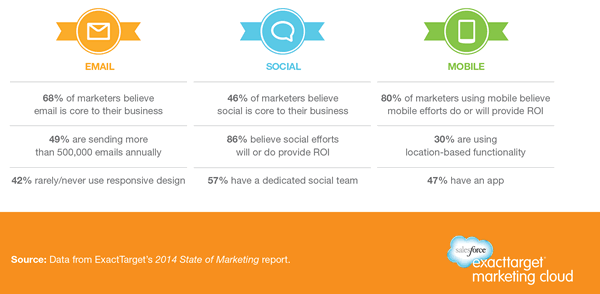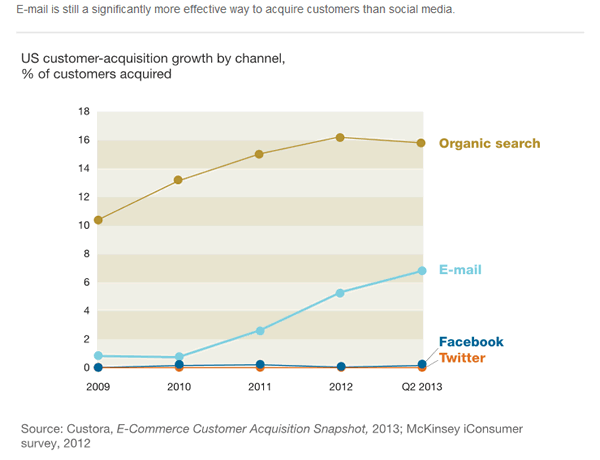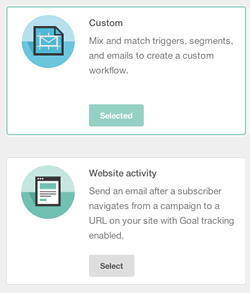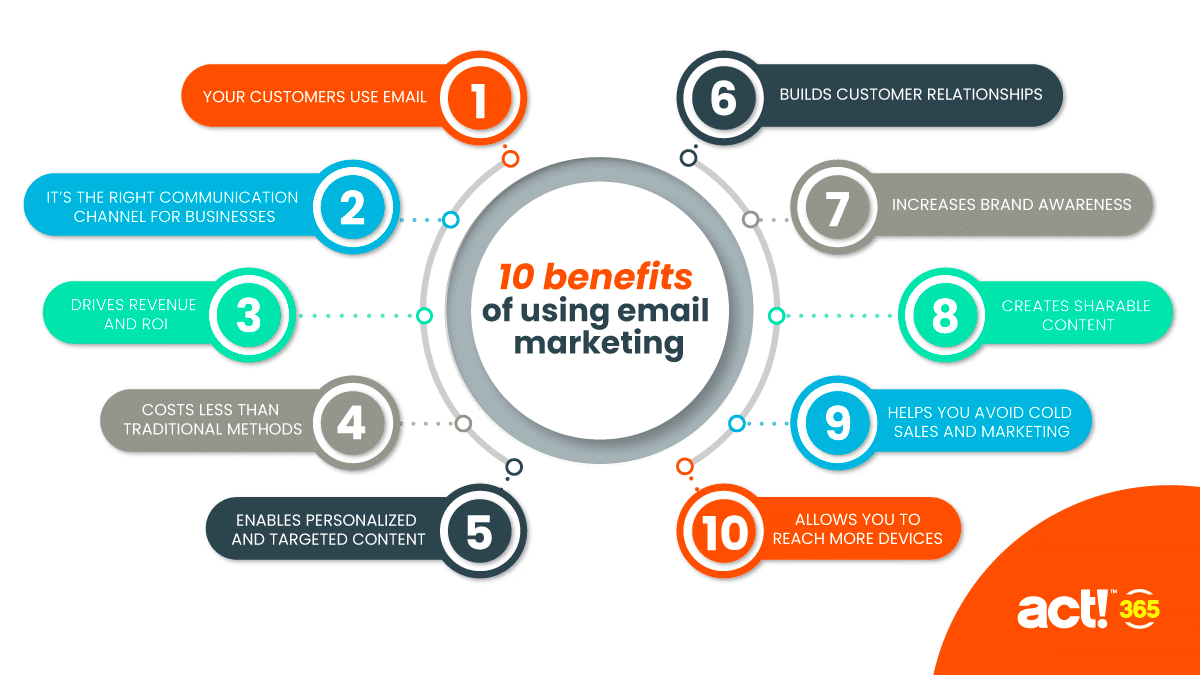Two digital marketing “techniques” have stood the test of time: email marketing and search engine marketing (the mix of search engine advertising and search engine optimization).
 Since way over a decade marketers get confronted with a multitude of new channels people use to interact with business. Even if today’s customer is channel-agnostic or omni-channel if you prefer, email marketing de facto remains a crucial element of most marketing mixes.
Since way over a decade marketers get confronted with a multitude of new channels people use to interact with business. Even if today’s customer is channel-agnostic or omni-channel if you prefer, email marketing de facto remains a crucial element of most marketing mixes.
With each new generation of marketers joining the ranks of digital marketing, the quest for solid email marketing advice comes back. In this guide, we offer an overview of email marketing, what it can do and how it fits in an integrated marketing approach, with these new generations in mind but also to refresh the minds of marketers who have embraced email marketing since a long time and want to optimize their email marketing efforts.
This email marketing guide will continue to grow and is based on over 15 years of email marketing practice and numerous papers and blogs on email marketing we wrote since the end of the nineties for email marketing, marketing automation and marketing software and marketing technology (MarTech) vendors and experts. It also will contain all tips we published on our own email marketing blog, which is now getting integrated here.
Email marketing remains very popular but evolves: what has changed
Let’s start with a quick overview of the macro-evolutions regarding email marketing. The basic principles of good email marketing haven’t changed that much.
What has changed are are the place and role of email marketing, the shift away from the “one size fits all”, ad hoc campaign and “batch and blast” mentality, the platforms of email marketing service providers (ESPs), the “rules” and algorithms used by popular email clients (with an impact on, among others, inbox placement and the importance of engagement/relevance), the behavior of consumers (multi-channel, omni-channel, channel-agnostic), the advent of new devices where emails get read, the possibilities to test, integrate and optimize, and – in some countries – the legislation.
What also changed is the way email marketing is used in an integrated marketing context, with the mentioned shift away from the batch and blast email marketing program to triggered and lifecycle-based email.
Many marketers today de facto use marketing automation software but very often only the email marketing features these platforms offer are used in reality. Last, but not least (and this summary is not exhaustive), we should mention the focus on data-driven marketing (also predictive analytics), ongoing personalization and optimization efforts/possibilities to improve email marketing, the growing role of mobile/responsive and the view of email marketing in the connected customer’s journey and lifecycle.
Despite messages that email marketing is dead that we’ve been hearing for close to a decade now, reality is that email marketing is doing very well, thank you very much. Many reports show it but just look at your own inbox.
Twitter, for instance, wants to drive its users to its platform by sending regular updates on what is popular in your network or follow suggestions via…email. The same goes for many other – if not all – social networks and social media platforms. And you have your newsletters and email alerts you have signed up to, from blogs to mainstream media, RSS alerts regarding the topics you follow, your preferred brands and retailers, you name it. And that’s just the tip of the email marketing iceberg: newsletters and promotions. We haven’t even covered confirmation emails, triggered emails and all the other techniques yet.

Email marketing and customer-centricity in the era of data-driven marketing
Email marketing continues to mature but also evolves in an age of channel integration, integration of various marketing software and customer-oriented systems and integrated marketing in function of the customer and of ever more – big data.
Email service providers are adding more features to enable marketers to take advantage of all this data to make their email marketing more customer-oriented, personalized and simply better, in correlation with the preferences, intent, behavior, history and often real-time interactions on other channels of customers.
In the end, customer-centricity and the customer experience are probably the driving forces in most email marketing changes we’ve witnessed over the past 15 years. Truth be told: quite some email marketers have jumped on the big data (or better: smart and actionable data) evolution to optimize the return and tactical metrics they use, calling it customer experience optimization but not really embracing a more customer-oriented and “different”, integrated approach around the customer, in the end what most digital transformation efforts are about in a marketing context.
Simply said: there’s a difference between claiming to have a customer-oriented and data-driven marketing approach on one hand and really finding the sweet spots where customer value and business value meet each other, on the other hand. It’s one of the risks of the data-driven marketing mantra and data obsession overall. It’s also one of the risks of marketing automation if the customer experience, journey, lifecycle and intent are not taking enough into account.
Nevertheless, the keywords will be data-driven marketing, automation, personalization (beyond email as such too), omni-channel, mobile, the overall customer journey, lifecycles and customer-centricity in 2015 (as well). Smart businesses will also look at the journey and customer first in an integrated way beyond email, as part of overall digital transformation exercises in marketing, as previously mentioned. And when we say digital transformation in a customer-facing context today, we de facto mainly talk about digital customer experiences, integration, mobile, data and so on.

Email marketing software or marketing automation software?

Marketing automation software definitely has many benefits over email marketing software. But it depends on your individual context, resources, goals, capabilities and of course customers.
In recent years, we see an increasing number of cheap email marketing software providers offer essential automation features, for instance regarding triggered emails based on segments. In 2014, MailChimp, for instance, added several of these non-traditional features, showing the growing importance of marketing automation.
The other way around, marketing automation software vendors with a more than decent set of features have entered the market at pricing levels that make them viable options for organizations that traditionally couldn’t afford them. And then there is a bunch of marketing software from other categories that de facto comes with email marketing and sometimes even marketing automation features included. In other words: there is something for everyone and the lines are blurring.
However, features are still function of goals. And many businesses are just starting and can do very well with email marketing software. If you can fulfil your goals and those of your customers and others in your company (for instance, regarding reporting requirements) and you haven’t used all the functions your software offers, in connection with other platforms you use, marketing automation software is not a must, unless the cost (also indirect costs such as integrations and/or time spent on time-consuming tasks) of your current approach far outweighs the savings you could make when going for a marketing automation solution – and you’re sure you have the skills and resources.
In this regard, one of the most often forgotten resources is the proper content (in the sense of content marketing and in the sense of promotions and whatnot that your customers want). A lack of good (relevant) and timely content is one of the key reasons why email marketing and marketing automation fail. It’s not just about pushing a button, it’s also about people and processes (content, planning, productions, testing, taking into account direct and indirect subscriber input systematically, etc.).
Knowing when email marketing works: the integrated challenges
How do you if your email marketing program works? Many marketers will still predominantly look at direct response metrics. They will focus on parameters such as open rates, click-through rates, etc.
While all of these metrics matter, in a more integrated and realistic view they are not enough. Email marketing works when it fits what customers and other “recipients” (people) want. That can show in direct metrics, in unsubscribes but also in parameters beyond the actual email marketing program. It’s important to realize email marketing has (and always had) a branding impact, for instance. Simple example: if you are registered to a promotions newsletter of a retailer, you might buy a promoted product in an offline shop of that retailer when the time to do so has come.
The other way around, metrics such as clicks and even downloads aren’t necessarily an expression of interest in your business or products. We still all too often get telephone calls by sales reps, contacting us because we downloaded one of their papers. When someone downloads a paper, he’s interested in that paper. You need to know more in order to gauge their actual interest, one of the reasons many use marketing automation and lead nurturing techniques nowadays. The multi-channel, cross-channel, omni-channel and channel-agnostic reality makes this challenge of knowing when email marketing works even bigger. Therefore, it’s important to integrate and have a better look on the customer overall and focus on multiple touchpoints. While this can be achieved using an email marketing software, connected with web analytics, CRM and a bit of human wisdom (relying too much on automation can make you miss opportunities), often other tools are required but most of all an attribution model and more holistic view can be smart, again revolving around the customer.
Last but not least, also look at the activity and hygiene of your “list” (more on reactivating inactive subscribers here) and in a lifecycle-based email marketing approach consider the metrics across all flows and lifecycle-triggered elements.
Email marketing for the channel-agnostic consumer
Businesses that want to get the most out of email marketing realize that the traditional approach is not enough to engage the channel-agnostic customer.
The result is that companies that use traditional email marketing solutions and methods are increasingly confronted with the limits of what they can achieve with their current solutions and marketing IT stacks. It is time for a new model and a new paradigm with a shift from channel and campaign to preference and customer. A shift that has significant consequences for businesses that want to take their email programs and interactions to the next level, as well on the strategy, planning, measurement, integration and solution level.
The challenges in email marketing call for a different approach
As said, email marketing is not a stand-alone tactic. It is part of a broader integrated marketing strategy aimed at individual customers to achieve your goals.
This applies to all interaction channels. Despite this obvious finding, marketers are often looking more at the media and channels than at the needs and preferences of the customer. However, it is not the channels that are important, but the customer (experience) and the created value. This does not mean that there is no more need for specialists in specific channels. Email, social, mobile etc. all require different skill sets. Since email marketing is evolving, the need for specialists will even increase. However, the required skills will certainly include the ability to integrate email with other channels.
Some contextual changes affecting email marketing
The most important changes influencing the efficiency and position of email marketing (and other marketing techniques) are known:
- People have more control on the communication and information gathering processes.
- New channels offer additional interaction possibilities and strengthen the demand of people using them to engage in highly personalized dialogues.
- There is a staggering increase in the number of advertising and marketing messages.
- People trust company messages less and rely on their networks more frequently.
- Internet is everywhere and new forms of access are taking the lead, such as mobile.
The consequences of all these changes are among others, a drop in the conversion of many email marketing programs and a growing battle for a place in the inbox, a place that is becoming increasingly valuable.
Techniques such as segmentation and personalization help companies overcome email overload. Subscribers of emails are no longer considered to be email addresses, but people of flesh and blood that seek dialogue and pertinent information, leading to an increased need of timely and relevant content.
Businesses also try to optimize the frequency of their emails and integrate them with other channels. Even though all these activities are important, they are not enough. A fundamental review of the email process is needed. One in which the message and the channel are secondary to the overall interaction process with the individual customer who uses various media and information sources.
What goals can email marketing serve?
Email marketing and the various techniques it encompasses can be used for virtually all marketing goals. In the same way you want to have a plan for other marketing tactics and your integrated marketing plan, you want to have a plan for your email marketing programs.
And here as well, knowing what you want to achieve (the business goals) and how to achieve it (essentially by meeting the goals of subscribers and doing better all the time), are two questions to answer. All the rest is smart thinking, being close to your “audiences”, continuously improving, tactics, processes and finding that magical sweet spot where your goals and those of your customers meet. And of course acting upon the insights you acquire and thinking beyond just email marketing.
More about the goals email marketing can serve

Building, growing and engaging email lists: a human approach
Once you know what you want to achieve with your email marketing program and before being able to send any email, obviously you need an email (subscriber) list.
Many organizations still have a siloed email marketing list. Others still have to start. And some have a contact list that is, among others, partially used for email marketing but goes beyond that. Enterprise marketers increasingly use customer data platforms to unify their customer data to avoid silos.
No matter the context it’s clear that active, clean and ideally segmented (sub)lists or list segments in a more traditional sense, are crucial. Look at your contacts and lists as communities of people and make sure your goals and what your contacts seek are properly aligned. Below are some resources regarding email lists.
You can read some tips and more on building your email marketing list here. Some tips:
- Have a subscription form for your email marketing newsletter and other forms of emails on your website or blog (and on social media where relevant and possible).
- Don’t just use one form to enable people to subscribe to your emails.
- Be transparent about what you intend to do with the personal data of subscribers and make sure you don’t combine various purposes which could be in breach with privacy regulations.
- Use more forms on your website and other properties online to provide new subscribers the opportunity to sign in when they want, with the opt-in rules kept in mind.
Use email signatures. - Create trust, choice, and clarity – test various ways to do so and don’t look at people as addresses you have or want in a list.
- Offer an incentive for subscribing to your email list (again, keep in mind regulations).
- Make the process to subscribe to your list, whether it’s for newsletters, promotions and so forth effortless, clear and easy. Offer choice but don’t confuse.
- Never ask for too much information in the beginning.
- Set up a viral recruitment campaign.
- Learn from unsubscribes: optimize.
Find new ways to incentivize your opt-in. - Use offline interactions (beware you have clear consent or any other way that is valid in the context of the local privacy rules).

